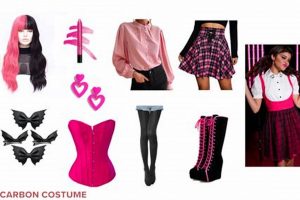Creating a self-made archaeologist’s outfit involves assembling readily available clothing and accessories to mimic the iconic adventurer’s appearance. For instance, a brown fedora, a leather jacket, a khaki shirt and trousers, and a whip are the core components typically used.
This approach to costuming offers several advantages, including cost-effectiveness and personalization. Individuals can tailor the outfit to their specific body type and preferences, potentially resulting in a more authentic or comfortable representation. Furthermore, the process encourages creativity and resourcefulness, often utilizing repurposed or thrifted items, thus promoting sustainable practices.
The following sections will detail the specific garments and accessories required, providing guidance on sourcing, modification, and assembly techniques to achieve a convincing and unique result.
Tips for Crafting an Authentic Archaeologist’s Outfit
Achieving a convincing self-made archaeologist’s ensemble necessitates attention to detail and careful selection of components. The following guidelines offer insights into replicating the character’s signature look.
Tip 1: Fedora Selection: Opt for a high-quality felt fedora, preferably in a dark brown or tan hue. Ensure the brim width and crown shape are proportionate to one’s facial structure. Consider distressing the hat slightly for a weathered appearance.
Tip 2: Jacket Material: A leather or leather-look jacket is crucial. A bomber or safari style in brown leather is most accurate. Prioritize durability and comfort, as the jacket is a prominent element.
Tip 3: Shirt and Trousers: A khaki or off-white shirt is ideal, coupled with matching khaki trousers. Cotton or a durable blend is recommended. The fit should be comfortable and allow for movement.
Tip 4: Whip Procurement: A genuine leather bullwhip adds authenticity. If a real whip is impractical, a well-crafted prop whip provides a suitable alternative.
Tip 5: Boot Considerations: Durable leather boots are essential. Ankle-high work boots or riding boots in brown or tan are appropriate choices. Ensure they are comfortable for extended wear.
Tip 6: Accessory Details: A satchel or shoulder bag, often made of canvas or leather, complements the outfit. Consider adding a replica pistol holster for enhanced realism (exercise caution regarding legal restrictions).
Tip 7: Distressing Techniques: To achieve a battle-worn look, subtly distress the clothing and accessories. This may involve light staining, scuffing, or adding minor imperfections.
By adhering to these tips, a more authentic and convincing self-made archaeologist’s look can be achieved, enhancing the overall impact and recognizability of the costume.
The subsequent section addresses advanced customization techniques to further elevate the ensemble’s accuracy and uniqueness.
1. Hat
The fedora is arguably the most recognizable element in a self-made archaeologist’s outfit. Its specific shape and material are crucial for achieving a convincing portrayal. The fedora functions as a visual shorthand, immediately signaling the character being emulated. Deviations from the classic fedora shape dilute the recognizability of the intended costume, thereby diminishing the overall effect. For instance, a baseball cap or a different style of hat would fundamentally alter the impression, rendering the costume unrecognizable to many observers.
The importance extends beyond mere aesthetics. The fedora style, often featuring a center dent and pinched front, reflects the era and genre associated with the character, harking back to adventure serials of the 1930s and 1940s. This historical context adds depth to the costume, making it more than just a collection of clothes. Replicating the fedora’s shape accurately demonstrates attention to detail and a thorough understanding of the character’s visual identity, directly impacting the success of a do-it-yourself project.
In summary, the accurate reproduction of the fedora’s shape is paramount when creating an archaeologist’s outfit at home. It serves as a crucial visual identifier, providing historical context and contributing significantly to the overall effectiveness of the costume. The challenge lies in sourcing or modifying a hat to match the specific style, but the effort is directly proportional to the impact and recognizability of the final product.
2. Jacket
The leather jacket, specifically of the bomber or A-2 style, is a critical element for a successful self-assembled archaeologist’s outfit. Its presence contributes significantly to the immediate recognition and authenticity of the costume.
- Material Authenticity
The use of genuine leather, or a convincing substitute, is paramount. The texture, grain, and weight of the material directly impact the jacket’s appearance and believability. While cost considerations may necessitate synthetic alternatives, opting for high-quality faux leather can minimize the deviation from the intended aesthetic. The durability of the material is also a factor, as a well-worn appearance is often desirable for replicating the character’s seasoned look.
- Style and Cut
The A-2 bomber jacket silhouette is characterized by its fitted waist, ribbed cuffs, and often a snap-down collar. The jacket should sit comfortably on the torso without appearing overly bulky or restrictive. Deviations from this cut, such as oversized or excessively modern designs, will detract from the costume’s accuracy. The color should ideally be a shade of brown, ranging from a light tan to a dark chocolate hue, reflecting the weathered and practical nature of the character’s attire.
- Distressing and Weathering
Achieving a realistic portrayal often involves artificially aging the leather jacket. This can be accomplished through various techniques, including the application of leather conditioners to soften the material and induce creasing, the use of fine sandpaper to create subtle scuff marks, and the strategic application of dirt or mud to simulate field wear. The level of distressing should be carefully considered to avoid overdoing it, as excessive damage can appear contrived and detract from the overall effect.
- Sourcing and Modification
Obtaining an appropriate leather jacket may involve purchasing a new or vintage garment. Thrift stores and online marketplaces can be valuable resources for finding affordable options that closely resemble the desired style. In some cases, modifications may be necessary, such as altering the fit, removing extraneous details (e.g., modern zippers or logos), or adding period-appropriate patches or embellishments. These alterations require careful planning and execution to maintain the integrity of the jacket and ensure that it complements the overall c
ostume.
In conclusion, the leather bomber jacket is a cornerstone of a successful self-made archaeologist’s costume. Attention to material, style, weathering, and sourcing is crucial for creating a recognizable and authentic representation. The jacket serves not only as a garment but also as a visual cue that instantly connects the wearer to the iconic character.
3. Shirt
The khaki or off-white shirt is an integral, albeit understated, component of a self-assembled archaeologist’s outfit. Its selection directly impacts the costume’s overall authenticity and visual coherence. The shirt functions as a foundational garment, influencing the perception of other elements such as the jacket and trousers. A shirt of incorrect color or material diminishes the credibility of the entire ensemble. For example, a brightly colored or patterned shirt would immediately detract from the intended rugged and functional aesthetic. The color choice further situates the character within a specific historical and geographical context, evoking images of expeditions in arid and tropical environments. Thus, the decision to use khaki or off-white is not arbitrary; it reflects a deliberate choice to adhere to the character’s established visual identity.
Practical considerations extend beyond mere aesthetics. The choice of material impacts comfort and functionality, particularly important for costumes intended for extended wear. Cotton or linen blends offer breathability and durability, crucial for simulating the conditions of an archaeologist’s field work. Furthermore, the shirt’s fit influences the overall silhouette of the costume. A well-fitted shirt, neither too loose nor too tight, ensures a balanced and proportional appearance, complementing the jacket and trousers. The shirts collar style (e.g., point, button-down) should also align with the era and character depiction for enhanced accuracy.
In summary, the seemingly simple decision to use a khaki or off-white shirt in a self-made archaeologist’s costume carries significant weight. It serves as a visual anchor, reinforcing the costume’s authenticity and historical context. While challenges may arise in sourcing the precise shade or material, the effort invested in selecting an appropriate shirt is directly proportional to the success and recognizability of the completed costume. Its unassuming nature belies its crucial role in achieving a convincing portrayal.
4. Trousers
Durable khaki pants constitute a foundational element of any self-constructed archaeologist’s costume. The choice of trousers directly influences the overall accuracy and practicality of the ensemble. Khaki, a durable twill fabric, provides the necessary resilience to simulate the rigors of archaeological expeditions. The color, historically associated with military uniforms and exploration, lends authenticity to the persona. Examples from the film franchise consistently showcase the character donning khaki pants, cementing the garment’s visual association with the adventurer’s identity. Deviation from this standard diminishes the immediately recognizable aspects of the character. The absence of durable fabric would compromise the impression of a seasoned explorer capable of withstanding demanding environments. The selection, therefore, requires careful consideration, factoring in both aesthetic and functional properties.
The practical implications of selecting appropriate trousers extend beyond mere visual resemblance. The fabric’s weight and weave determine its resistance to tears, abrasion, and staining factors encountered during simulated field work. The cut and fit influence the wearer’s range of motion, impacting comfort and mobility during extended periods of wear. Practical applications include selecting pants with reinforced seams, multiple pockets for storing simulated artifacts or tools, and a comfortable waistband for prolonged wear. Furthermore, distressing techniques, such as artificial weathering and staining, can enhance the garment’s realism, conveying a sense of experience and immersion in the role.
In summary, the durable khaki pants are not merely a component, but a crucial investment in realizing an authentic and practical self-made archaeologist’s costume. The color and material evoke a historical connection, while the durability ensures the garment can withstand simulated exploration activities. While alternatives exist, adhering to the khaki standard maximizes the costume’s recognizability and elevates its overall effectiveness. The challenge lies in finding the balance between affordability, durability, and accuracy, but the effort is directly proportional to the final result.
5. Whip
The inclusion of a whip is a defining element in a self-made archaeologist’s outfit. Deciding between an authentic whip and a substitute involves navigating factors such as cost, safety, and practicality, all crucial to successful costuming.
- Material Considerations
Authentic whips are typically crafted from leather, requiring specialized skills in braiding and construction. Substitutes may utilize nylon or other synthetic materials, offering lower cost and easier maintenance. The chosen material affects both the visual realism and the functional properties of the whip, such as its weight, flexibility, and ability to crack.
- Safety Implications
A genuine leather whip, when used improperly, poses a significant risk of injury to both the user and bystanders. Cracking a whip requires training and practice to avoid accidental strikes. Substitute whips, often made of lighter materials, present a reduced risk of injury, making them a safer option for costume purposes, particularly in crowded environments. Safety should be paramount when considering handling and using the whip prop.
- Cost and Accessibility
Authentic, high-quality leather whips can be expensive, requiring a significant investment. Sourcing a well-made whip may also present challenges, as specialized vendors are often required. Substitute whips, readily available at costume shops and online retailers, offer a more affordable and accessible alternative. Cost-effectiveness is a prime consideration when determining authenticity versus substitution. The overall budget for the costume directly impacts the whip component.
- Realism vs. Practicality
An authentic whip adds a layer of realism to the costume, enhancing the overall visual impact. However, its size and weight can be impractical for certain settings, such as crowded conventions or parties. A substitute whip, while potentially lacking the same level of detail, offers greater portability and ease of handling. The intended use of the costume influences the trade-off between realism and practicality in whip selection.
The decision to employ an authentic whip or a substitute in a self-made archaeologist’s costume directly impacts the costume’s cost, safety, and visual appeal. While a genuine whip offers superior realism, a substitute may be more practical and safe for most applications. Careful consideration of these factors is essential for achieving a satisfactory outcome. All aspects of costuming should be considered.
6. Details
The effectiveness of self-constructed archaeologist attire hinges significantly on the selection and integration of appropriate details, specifically the satchel and complementary accessories. These elements are not merely decorative additions but serve as critical visual cues that reinforce the character’s identity and purpose. The absence or misrepresentation of these details can diminish the recognizability and believability of the overall impression. For instance, substituting a modern backpack for the character’s distinctive satchel immediately undermines the costume’s intended aesthetic, signaling a lack of attention to key visual signifiers. Conversely, an authentic-looking satchel paired with period-appropriate accessories, such as a canteen or map case, elevates the costume, enhancing its accuracy and immersive quality.
The selection of specific accessories should reflect the character’s profession and historical context. A leather shoulder bag, reminiscent of those used by explorers and academics, is a more appropriate choice than a contemporary nylon bag. Similarly, a replica compass or journal adds a layer of authenticity, suggesting a character engaged in scholarly pursuits and adventurous undertakings. Real-world examples of successful self-made archaeologist costumes often feature carefully curated accessory collections, sourced from vintage stores, prop suppliers, or even handcrafted to achieve the desired level of realism. These details, while seemingly minor, contribute significantly to the overall impression, transforming a basic collection of clothing into a convincing portrayal of the iconic character.
In conclusion, the inclusion of a historically accurate satchel and complementary accessories is paramount for achieving a compelling self-made archaeologist’s costume. These details serve as crucial visual identifiers, reinforcing the character’s identity and profession. While sourcing appropriate accessories may require additional effort and expense, the impact on the overall effectiveness of the costume justifies the investment. Overlooking these elements results in a diluted and less convincing portrayal, whereas careful attention to detail elevates the costume to a higher level of authenticity and recognizability.
Frequently Asked Questions Regarding Self-Assembled Archaeologist Attire
The following addresses common inquiries and misconceptions pertaining to the creation of a convincing self-made archaeologist’s costume. These questions aim to provide clarity and guidance for those seeking to replicate the iconic adventurer’s look.
Question 1: What constitutes the most crucial element in a self-made archaeologist’s ensemble?
The fedora is widely considered the most recognizable and essential element. Its distinctive shape immediately signals the character being emulated. However, a combination of appropriate garments and accessories is necessary for a truly convincing portrayal.
Question 2: Is it permissible to substitute synthetic materials for leather in the costume?
While genuine leather enhances authenticity, high-quality synthetic alternatives are acceptable, particularly for budget-conscious individuals. The key is to select materials that closely mimic the appearance and texture of leather.
Question 3: How can the costume be realistically distressed to convey a sense of age and wear?
Subtle distressing techniques, such as light sanding, staining with diluted tea or coffee, and gentle scuffing, can effectively simulate wear and tear. Avoid excessive or artificial-looking damage.
Question 4: Are there any legal considerations regarding the inclusion of a replica firearm in the costume?
Local and national laws regarding replica firearms vary significantly. It is imperative to research and comply with all applicable regulations before incorporating such an item into the costume. Displaying a replica firearm in public may be restricted or prohibited in certain jurisdictions.
Question 5: What are the recommended footwear options for a self-made archaeologist’s costume?
Durable leather boots, such as ankle-high work boots or riding boots, are ideal. The color should be brown or tan, and the boots should be comfortable for extended wear. Avoid overly modern or stylized footwear.
Question 6: Can the costume be adapted for different climates and weather conditions?
Modifications may be necessary to accommodate varying climates. In warmer weather, lighter-weight fabrics and breathable materials are recommended. In colder conditions, additional layers, such as a wool sweater or vest, can be added beneath the jacket.
The creation of a compelling self-made archaeologist’s costume requires attention to detail, careful material selection, and adherence to established visual cues. While individual preferences may vary, the guidelines outlined above provide a solid foundation for achieving a recognizable and authentic portrayal.
The following section provides recommendations for sourcing materials and supplies for the project.
Achieving a Convincing Self-Made Archaeologist Attire
The preceding discourse has illuminated the intricacies of the “indiana jones costume diy” endeavor, emphasizing critical aspects ranging from fedora selection to accessory procurement. Successful execution necessitates meticulous attention to detail, prioritizing authenticity and practicality in garment and prop choices. Careful consideration of fabric, fit, and weathering techniques constitutes the cornerstone of a believable portrayal. The combination of these elements contributes to a visually compelling representation of the iconic character.
The construction of such an outfit represents more than mere replication; it embodies a dedication to craftsmanship and historical accuracy. The information presented encourages potential costume creators to embark on this project with diligence and discernment, appreciating the importance of each component in achieving a truly memorable and recognizable ensemble. The pursuit of quality over convenience ultimately determines the success of any self-made archaeologist attire.







